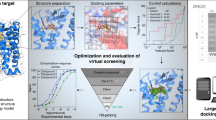Abstract
Over recent years many enrichment studies have been published which purport to rigorously compare the performance of two or more docking protocols. It has become clear however that such studies often have flaws within their methodologies, which cast doubt on the rigour of the conclusions. Setting up such comparisons is fraught with difficulties and no best mode of practice is available to guide the experimenter. Careful choice of structural models and ligands appropriate to those models is important. The protein structure should be representative for the target. In addition the set of active ligands selected should be appropriate to the structure in cases where different forms of the protein bind different classes of ligand. Binding site definition is also an area in which errors arise. Particular care is needed in deciding which crystallographic waters to retain and again this may be predicated by knowledge of the likely binding modes of the ligands making up the active ligand list. Geometric integrity of the ligand structures used is clearly important yet it is apparent that published sets of actives + decoys may contain sometimes high proportions of incorrect structures. Choice of protocol for docking and analysis needs careful consideration as many programs can be tweaked for optimum performance. Should studies be run using ‘black box’ protocols supplied by the software provider? Lastly, the correct method of analysis of enrichment studies is a much discussed topic at the moment. However currently promoted approaches do not consider a crucial aspect of a successful virtual screen, namely that a good structural diversity of hits be returned. Overall there is much to consider in the experimental design of enrichment studies. Hopefully this study will be of benefit in helping others plan such experiments.








Similar content being viewed by others
Abbreviations
- CCDC:
-
Cambridge Crystallographic Data Centre
- RCSB:
-
Research collaboratory for structural bioinformatics
- PDB:
-
Protein data bank
- COX2:
-
Cyclooxygenase 2
- ER:
-
Oestrogen receptor
- sPLA2:
-
Secretory phospholipase 2
- RMSD:
-
Root mean square deviation
- VS:
-
Virtual screening
- ADME:
-
Absorption, distribution, metabolism, excretion
- ROC:
-
Received operating characteristic
- AUC:
-
Area under curve
References
Cole JC, Murray CW, Nissink JWM, Taylor RD, Taylor R (2005) Proteins 60:325
Kellenberger E, Rodrigo J, Muller P, Rognan D (2004) Proteins 57:225
Perola E, Walters WP, Charifson P (2007) J Chem Inf Model 47:251
Kontoyianni M, McClellan LM, Sokol GS (2004) J Med Chem 47:558
Warren GL, Andrews CW, Capelli A-M, Clarke B, LaLonde J, Lamber MH, Lindvall M, Nevins N, Semus S, Senger S, Tedesco G, Wall ID, Woolven JM, Peishoff CE, Head MS (2006) J Med Chem 49:5912
Chen H, Lyne PD, Giordanetto F, Lovell T, Li J (2006) J Chem Inf Model 46:401
Perola E, Walters SP, Charifson PS (2004) Proteins 56:235
Berman HM, Westbrook J, Feng Z, Gilliland G, Bhat TN, Weissig I, Shindyalov IN, Bourne PE (2000) Nucleic Acids Res 28:235
Jones G, Willett P, Glen R, Leach AR, Taylor R (1997) J Mol Biol 267:727
Kramer B, Rarey M, Lengauer T (1999) Proteins 37:22
Nissink JWM, Murray CW, Hartshorn MJ, Verdonk ML, Cole JC, Taylor R (2002) Proteins 49:457
Hartshorn MJ, Verdonk ML, Chessari G, Brewerton SC, Mooij WTM, Mortensen PN, Murray CW (2007) J Med Chem 50:726
Friesner RA, Murphy RB, Repasky MP, Frye LL, Greenwood JR, Halgren TA, Sanschagrin PC, Mainz DT (2006) J Med Chem 49:6177
Hendlich M, Bergner A, Günther J, Klebe K (2003) J Mol Biol 326:607
Pike ACW, Brzozowski AM, Walton J, Hubbard RE, Thorsell A-G, Li Y-L, Gustafsson J-A, Carlqusit M (2001) Structure 9(2):145
Schulz-Gasch TA, Stahl M (2003) J Mol Model 9:47
Verdonk ML, Chessari G, Cole JC, Hartshorn M, Murray CW, Nissink JWM, Taylor RD, Taylor R (2007) J Med Chem 50:726
Tucker TJ, Brady SF, Lumma WC, Lewis SD, Gardell SJ, Naylor-Olsen AM, Yan Y, Sisko JT, Stauffer KJ, Lucas BJ, Lynch JJ, Cook JJ, Stranieri MT, Holahan MA, Lyle EA, Baskin EP, Chen I-W, Dancheck KB, Krueger JA, Cooper CM, Vacca JP (1998) J Med Chem 41:3210
Verdonk ML, Chessari G, Cole JC, Hartshorn MC, Murray CW, Nissink JWM, Taylor RD, Taylor R (2005) J Med Chem 48:6504
Onodera K, Satou K, Hirota H. (2007) J Chem Inf Model 47:1609
Taken from I. Dramburg et al from http://cisrg.shef.ac.uk/shef2004/abstracts.htm
Huang N, Shoichet BK, Irwin JJ (2006) J Med Chem 49(23):6789
Communicated in a seminar by M. Nevins, 234th ACS National Meeting, COMP 150
Truchon J-F, Bayly CI (2007) J Chem Inf Model 47:488
Sheridan RP, Singh SB, Fluder EM, Kearsley SJ (2001) J Chem Inf Comput Sci 41:1395
Barker EJ, Gardiner EJ, Gillet VJ, Kitts P, Morris J (2003) J Chem Inf Comput Sci 43:346
Good AC (2007) 234th ACS meeting 2007, Abs 266
Olah M, Mracec M, Ostopovici L, Rad R, Bora A, Hadaruga N, Olah I, Banda M, Simon Z, Mracec M, Oprea TI (2004) In: Oprea TI (eds) Chemoinformatics in drug discovery. Wiley-VCH, New York, p 223
Acknowledgements
The author thanks Willem Nissink and Noel O’Boyle for assistance in setting up the docking studies presented here, Hongming Chen of AstraZeneca for supplying structure files and protocols for these studies and Richard Sykes for the GoldMine program used to carry out the analysis. Robin Taylor and Jason Cole are thanked for making perceptive and useful comments on the manuscript, and Simon Bowden, Marcel Verdonk, Chris Murray and Paul Mortensen are thanked for useful discussions.
Author information
Authors and Affiliations
Corresponding author
Rights and permissions
About this article
Cite this article
Liebeschuetz, J.W. Evaluating docking programs: keeping the playing field level. J Comput Aided Mol Des 22, 229–238 (2008). https://doi.org/10.1007/s10822-008-9169-8
Received:
Accepted:
Published:
Issue Date:
DOI: https://doi.org/10.1007/s10822-008-9169-8




